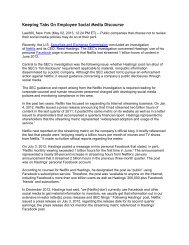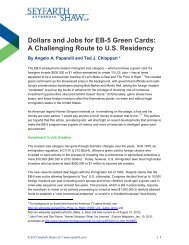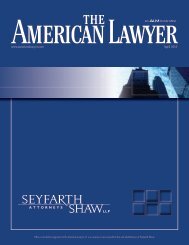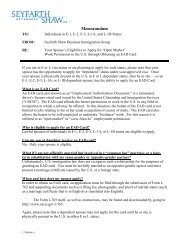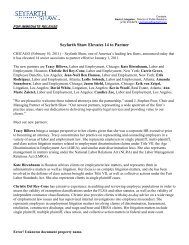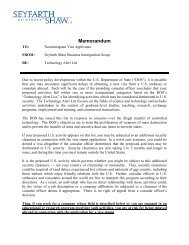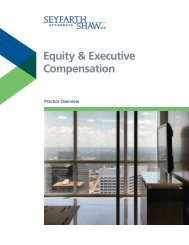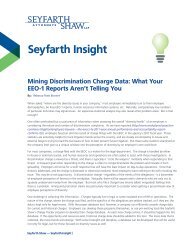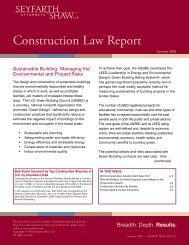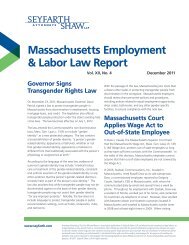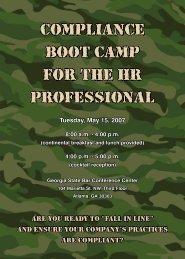Litigating California Wage & Hour and Labor Code Class Actions
Litigating California Wage & Hour and Labor Code Class Actions
Litigating California Wage & Hour and Labor Code Class Actions
You also want an ePaper? Increase the reach of your titles
YUMPU automatically turns print PDFs into web optimized ePapers that Google loves.
who does not meet the threshold compensation test is automatically disqualified from the<br />
exemption.<br />
The other requirements are that the manager (1) must have the power to hire <strong>and</strong> fire, or<br />
make recommendations on those topics that are given particular weight; (2) must supervise<br />
at least two full-time equivalent positions; (3) must “primarily” be engaged in managerial<br />
duties; <strong>and</strong> (4) must “customarily <strong>and</strong> regularly” exercise discretion <strong>and</strong> independent<br />
judgment. 13<br />
Most litigation in <strong>California</strong> arises out of element (3) above, because the <strong>California</strong><br />
Supreme Court in Ramirez v. Yosemite Water Co. 14 held that an employee meets element<br />
(3) only when the employee spends more than half of the work time on exempt duties. By<br />
contrast, under the FLSA’s executive exemption, the employer need only establish that<br />
management is the employee’s “primary duty,” which focuses on the relative importance of<br />
the duty rather than just the amount of time devoted to the duty. 15<br />
Aside from its emphasis on the percentage of work time devoted to exempt duties, there<br />
has been little <strong>California</strong> case law explaining precisely which duties qualify as exempt<br />
“managerial work.” Since July 2000, however, the <strong>Wage</strong> Order has expressly incorporated<br />
by reference the then-existing FLSA regulations defining “managerial” duties. 16<br />
Accordingly, federal authority construing those specific regulations is highly relevant in<br />
interpreting the <strong>California</strong> executive exemption. 17<br />
Some examples of exempt work set forth in the federal regulation are interviewing,<br />
selecting <strong>and</strong> training employees, setting <strong>and</strong> adjusting pay rates <strong>and</strong> work hours, directing<br />
work, keeping production records for subordinates, evaluating employees’ efficiency <strong>and</strong><br />
13<br />
14<br />
15<br />
16<br />
17<br />
See IWC <strong>Wage</strong> Order 1-2001(1)(A)(1); Nordquist v. McGraw-Hill Broad. Co., 32 Cal. App. 4th 555, 573 (1995)<br />
(“‘Discretion <strong>and</strong> independent judgment’ within the meaning of IWC Order No. 11-80 involves the comparison of<br />
possible courses of conduct, <strong>and</strong> acting after considering various possibilities. It implies that the employee has the<br />
power to make an independent choice free from immediate supervision <strong>and</strong> with respect to matters of significance . . .<br />
[meaning matters] of substantial significance to the policies or general operations of the business of the employer.”).<br />
20 Cal. 4th 785 (1999).<br />
Id. at 797; see also Baldwin v. Trailer Inns, Inc., 266 F.3d 1104, 1113-16 (9th Cir. 2001) (although store managers<br />
spent less than one-half their time on duties that met the federal executive exemption, they still qualified as exempt<br />
because management was found to be their “primary” or most important duty).<br />
See Whiteway v. FedEx Kinko’s Office & Print Servs., Inc., 2007 U.S. Dist. LEXIS 61239; 12 <strong>Wage</strong> & <strong>Hour</strong> Cas. 2d<br />
(BNA) 1503 (N.D. Cal. Aug. 21, 2007) (citing IWC <strong>Wage</strong> Order 7-2001 § (1)(A)(1)(e) <strong>and</strong> noting that it incorporates the<br />
federal definition of management as set forth in 29 C.F.R. § 541.102).<br />
See Whiteway, 2007 U.S. Dist. LEXIS 61239, at *22 (relying on federal cases construing 29 C.F.R. § 541.202 to<br />
interpret <strong>California</strong> executive exemption); see also Bldg. Material & Constr. Teamsters Union v. Farrell, 41 Cal. 3d 651,<br />
658 (1986) (“[f]ederal decisions have frequently guided our interpretation of state labor provisions the language of which<br />
parallels that of federal statutes”); Alcala v. Western Agric. Enters., 182 Cal. App. 3d 546, 550 (1986) (“It has been held<br />
that when <strong>California</strong>’s laws are patterned on federal statutes, federal cases construing those federal statutes may be<br />
looked to for persuasive guidance”).<br />
Seyfarth Shaw LLP | www.seyfarth.com <strong>Litigating</strong> <strong>California</strong> <strong>Wage</strong> & <strong>Hour</strong> <strong>Class</strong> <strong>Actions</strong> (12th Edition) 7



